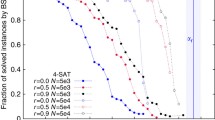Abstract
An analysis of the hardness of resolution of random 3-SAT instances using the Davis-Putnam-Loveland-Logemann (DPLL) algorithm slightly below threshold is presented. While finding a solution for such instances demands exponential effort with high probability, we show that an exponentially small fraction of resolutions require a computation scaling linearly in the size of the instance only. We compute analytically this exponentially small probability of easy resolutions from a large deviation analysis of DPLL with the Generalized Unit Clause search heuristic, and show that the corresponding exponent is smaller (in absolute value) than the growth exponent of the typical resolution time. Our study therefore gives some quantitative basis to heuristic restart solving procedures, and suggests a natural cut-off cost (the size of the instance) for the restart.
Similar content being viewed by others
References
D. Achlioptas, Lower bounds for random 3-SAT via differential equations, Theoretical Computer Science 265 (2001) 159–185.
D. Achlioptas, P. Beame and M. Molloy, A sharp threshold in proof complexity, in: Proceedings of STOC ‘01 (2001) pp. 337–346.
D. Achlioptas and M. Molloy, Analysis of a list-coloring algorithm on a random graph, in: Proceedings of FOCS 97 (1997) pp. 204–212.
D. Achlioptas, L. Kirousis, E. Kranakis and D. Krizanc, Rigorous results for random (2 + p)-SAT, Theoretical Computer Science 265 (2001) 109–129.
P. Beame, R. Karp, T. Pitassi and M. Saks, in: ACM Symp. on Theory of Computing (STOC’98) (Assoc. Comput. Mach., New York, 1998) 561–571.
M.T. Chao and J. Franco, Probabilistic analysis of two heuristics for the 3-satisfiability problem, SIAM Journal on Computing 15 (1986) 1106–1118.
M.T. Chao and J. Franco, Probabilistic analysis of a generalization of the unit-clause literal selection heuristics for the k-satisfiability problem, Information Science 51 (1990) 289–314.
V. Chvàtal and E. Szmeredi, Many hard examples for resolution, Journal of the ACM 35 (1988) 759–768.
C. Coarfa, D.D. Dernopoulos, A. San Miguel Aguirre, D. Subramanian and M.Y. Vardi, Random 3-SAT: The plot thickens, in: Proc. Principles and Practice of Constraint Programming (CP’2000), ed. R. Dechter, Lecture Notes in Computer Science, Vol. 1894 (2000) pp. 143–159.
S. Cocco and R. Monasson, Trajectories in phase diagrams, growth processes and computational complexity: how search algorithms solve the 3-satisfiability problem, Phys. Rev. Lett. 86 (2001) 1654.
S. Cocco and R. Monasson, Analysis of the computational complexity of solving random satisfiability problems using branch and bound search algorithms, Eur. Phys. J. B 22 (2001) 505.
S. Cocco and R. Monasson, Exponentially hard problems are sometimes polynomial, a large deviation analysis of search algorithms for the random satisifiability problem, and its application to stop-and-restart resolutions, Phys. Rev. E 66 (2002) 037101.
J. Crawford and L. Auton, Experimental results on the cross-over point in satisfiability problems, in: Proc. 11th Natl. Conference on Artificial Intelligence (AAAI-93) (The AAAI Press/MIT Press, Cambridge, MA, 1993) 21–27; Artificial Intelligence 81 (1996).
M. Davis, G. Logemann and D. Loveland, A machine program for theorem proving, Communications of the ACM 5 (1962) 394–397.
O. Dubois, P. Andre, Y. Boufkhad and J. Carlier, SAT versus UNSAT, in: Second DIMACS Challenge, eds. D.S. Johnson and M.A. Trick, DIMACS Series in Discrete Math. and Computer Science (Amer. Math. Soc., Providence, RI, 1993) 415–436.
O. Dubois, Y. Boufkhad and J. Mandler, Typical random 3-SAT formulae and the satisfiability threshold, in: Proc. of ACM-SIAM Symposium on Discrete Algorithms (2000) pp. 126–127.
O. Dubois, R. Monasson, B. Selman and R. Zecchina (eds.), Phase transitions in combinatorial problems, Theor. Comp. Sci. 265(1–2) (2001).
J. Franco, Results related to thresholds phenomena research in satisfiability: lower bounds, Theor. Comp. Sci. 265 (2001) 147–157.
E. Friedgut, Sharp thresholds of graph properties, and the k-sat problem, Journal of the AMS 12 (1999) 1017.
A. Frieze and S. Suen, Analysis of two simple heuristics on a random instance of k-SAT, Journal of Algorithms 20 (1996) 312–335.
I.P. Gent and T. Walsh, Easy problems are sometimes hard, Artificial Intelligence 70 (1994) 335–345.
I. Gent, H. van Maaren and T. Walsh (eds.), SAT2000: Highlights of Satisfiability Research in the Year 2000, Frontiers in Artificial Intelligence and Applications, Vol. 63 (IOS Press, Amsterdam, 2000).
C.P. Gomes, B. Selman, N. Crato and H. Kautz, J. Automated Reasoning 24 (2000) 67.
J. Gu, P.W. Purdom, J. Franco and B.W. Wah, Algorithms for satisfiability (SAT) problem: a survey, in: DIMACS Series on Discrete Mathematics and Theoretical Computer Science, Vol. 35 (American Mathematical Society, 1997) pp. 19–151.
A. Hartmann and M. Weigt, Typical solution time for a vertex-covering algorithm on finite-connectivity random graphs, Phys. Rev. Lett. 86 (2001) 1658.
T. Hogg, B.A. Huberman and C. Williams (eds.), Artificial Intelligence 81(1–2), Special Issue on Frontiers in Problem Solving: Phase Transitions and Complexity (1996).
T. Hogg and C.P. Williams, The hardest constraint problems: a double phase transition, Artificial Intelligence 69 (1994) 359–377.
A.C. Kaporis, L.M. Kirousis and E.G. Lalas, The probabilistic analysis of a greedy satisfiability algorithm, in: ESA (2002) pp. 574–585.
S. Kirkpatrick and B. Selman, Critical behavior in the satisfiability of random Boolean expressions, Science 264 (1994) 1297–1301.
D. Mitchell, B. Selman and H. Levesque, Hard and easy distributions of SAT problems, in: Proc. of the Tenth Natl. Conf. on Artificial Intelligence (AAAI-92) (The AAAI Press/MIT Press, Cambridge, MA, 1992) 440–446.
R. Monasson, R. Zecchina, S. Kirkpatrick, B. Selman and L. Troyansky, Determining computational complexity from characteristic ‘phase transitions’, Nature 400 (1999) 133–137.
R. Monasson, R. Zecchina, S. Kirkpatrick, B. Selman and L. Troyansky, 2 + p-SAT: Relation of typical-case complexity to the nature of the phase transition, Random Structure and Algorithms 15 (1999) 414.
A. Montanari and R. Zecchina, Boosting search by rare events, Phys. Rev. Lett. 88 (2002) 178701.
B. Selman and S. Kirkpatrick, Critical behavior in the computational cost of satisfiability testing, Artificial Intelligence 81 (1996) 273–295.
Author information
Authors and Affiliations
Rights and permissions
About this article
Cite this article
Cocco, S., Monasson, R. Restarts and exponential acceleration of the Davis-Putnam-Loveland-Logemann algorithm: A large deviation analysis of the generalized unit clause heuristic for random 3-SAT. Ann Math Artif Intell 43, 153–172 (2005). https://doi.org/10.1007/s10472-005-0426-4
Published:
Issue Date:
DOI: https://doi.org/10.1007/s10472-005-0426-4




